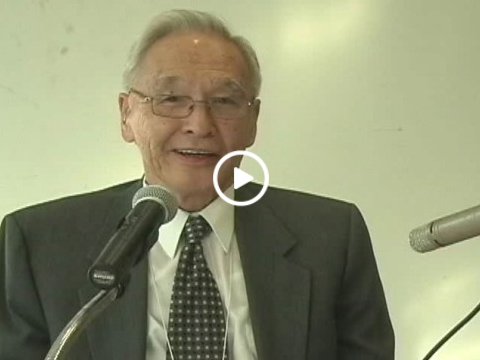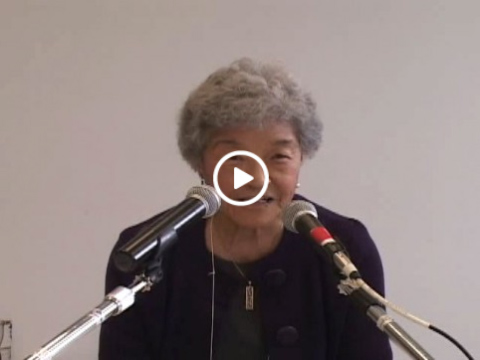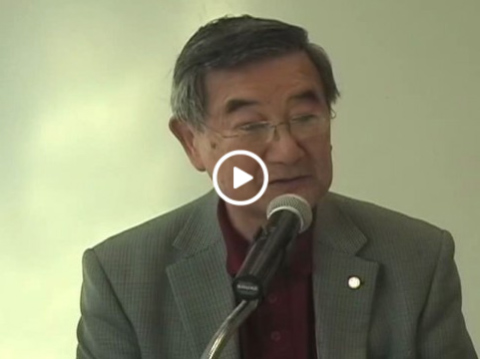A description of the Tashme Internment Camp and all of the aspects of internment life is but part of the story of Tashme. Personal stories of the people who lived there provide additional details, perspectives and color to the Tashme experience.
Do you have information, stories, photographs, or artifacts related to Tashme to share? Submit them HERE.
Marie Katsuno
One summer holiday turned into a five-year stay in an area of West Vancouver in the 1930’s. Due to pneumonia at a tender age and doctor’s advice that perhaps salty breeze may be a helpful remedy, a search for such a place ended at the Great Northern Cannery, a fish-canning village by the water where a few Japanese residents lived. Family acquaintances there and an unoccupied cabin resulted in a change of residence from our home in east Burnaby to this area.
Upon completion of junior and high schools in West Vancouver, the Pacific war erupted and we found ourselves returning to our home in Burnaby. With no other Japanese families in that area, it seems we were almost the last to evacuate in late October. We chose Tashme, the nearest relocation center, expecting to return home soon. We stored large items in the garage and even hid some food under the kitchen floor to be readily available upon our return and finally handed over the house keys to our neighbor across the street. READ MORE
Tak Negoro
When the war broke out in 1942, the Negoro family was living at 1254 Powell Street in Vancouver. Our father was dispatched with other adult males to Gosnell, a road camp on the North Thompson River. Due to a cave-in where a man was killed beside him, he was designated to accompany the body back to Vancouver, thus reuniting our family. In early October 1942, we were all sent to Tashme. When we arrived in Tashme, we were housed in ‘bell tents’, in an open field west of First Avenue. We went to a hall adjacent to the commissary for dinner which was stew on rice. I recall that the meat was not simmered very long, so it was chewy and tough. Globs of fat did not help the appetite either. READ MORE
Mas Yano
Before Tashme, the family lived in Fanny Bay on Vancouver Island. Mas started elementary school there and completed grade 1 before being relocated. His family got on a ship from Vancouver Island in spring 1942 and was taken to Hastings Park. His father was sent to a road camp at Blue River, north of Kamloops, and later joined the family at Tashme. The family lived on 5th Avenue in Tashme from 1942 to 1946. Mas was the second oldest of five children when they arrived at Tashme, and two more siblings were born in the camp. His family got a whole house because they were a large family.
Mas completed roughly grades 2 or 3 to grades 4 or 5 in Tashme. The teacher’s name was Miss Yoshiko Nikaido and school was in the D Building. Mas didn’t like school: “I’d rather be outside playing.” After Tashme, the family went to Sputum. Mas’s dad was a highrigger at Tashme and also at Spuzzum. He supplied the sawmill with wood. The sawmill was small. READ MORE
Victor Kadonaga
The outbreak of war in the Pacific had a devastating effect. The world seemed to be collapsing all around us. At Kitsilano High School, I was in the air cadet corps. One day, the vice-principal called all the Nisei students to a meeting. He informed us that we could no longer participate in such martial activities, which made me very unhappy. My father had been sent away to some unknown roadcamp. I noticed fewer and fewer older Nisei around. With Dad gone, I reluctantly had to quit school to earn some money. Mom looked sad, but she couldn’t object. The family had to survive, so I found work in a sawmill across town. READ MORE
Frank Moritsugu
Apparently, one issei father in the neighbourhood wondered why one classroom was lit up on that Saturday evening, and came into the school and peeked through the window of the classroom door. Word got around quickly and the next day or so, most of us were lectured directly or indirectly about our supposed carrying-on. In fact the next year, the graduates association decided to hold the party downtown instead. We went to a new restaurant on Main Street just south of Japantown’s Powell Street. At the New Pier Café, we Kits kids could try to jitterbug to In the Mood on its jukebox without any worries. READ MORE
Moon Above the Ruins
There is only the moon
above
the ruins of Tashme.
Takeo came out
of his internment cabin
playing his shakuhachi
a mournful tune
blowing dry through the bamboo
tunnel of that instrument
minor notes bent to the wind
rose to the parched, mad moon
during that early august
one by one
the other prisoners
emerged
into the dry light
looking for the sun
that was never
to rise again
we sought
the warmth of each other
we knew that time
was over
one by one
we left the camp
and ventured in-
to the cool mountain
breezes
that came down and blew
through our shrinking selves
arid cracked voices drew
together and rode
bareback
on the hollow notes
of that old flute
until the rock mountain faces
sang back to us
an ancient pentatonic
song
there is only the moon
since the august sun
exploded over hiroshima
burning paper cranes
and freezing shadows
during the cusp of sunrise
and moonset.
for hisashi goromaru
Hiroshima-ken
1910 - 1987
Tashme, B.C.
1942 - 1945
by Terry Watada
Letters Describing Tashme From Anglican Church of Canada “Living Message”
The Anglican Church of Canada sent missionaries to Tashme to aid in the support of the community. In addition to church services for the residents, the church organized and provided teachers to the kindergarten. The following describes details of life in Tashme and personal perspectives of the experience of one kindergarten teacher Ms Frances Belle Hawkins. READ MORE
Henry’s Glasses
Produced by: Brendan Uegama & Nicole G Leier
Directed by: Brendan Uegama
Released: 2010
Duration: 20 minutes
Moving Images Distribution
Henry’s Glasses, a dramatized story of a young boy and his mother, illustrates what life was like in Tashme. In the film, a young boy helps an elderly man find hope in dark times.
Henry's Glasses from Brendan Uegama, CSC on Vimeo.
SEDAI VIDEOS
The following first hand accounts of four Tashme camp internees are part of the SEDAI Legacy Project of the Japanese Canadian Cultural Centre in Toronto. SEDAI is dedicated to collecting and preserving the stories of earlier generations of Canadians of Japanese ancestry for all future generations. The videos, recorded in 2010, recall interesting details of events and experiences before and during internment in Tashme.
Arnold
Born in Collingwood Vancouver BC, Arnold recaptures his war years in Tashme, and speaks about the importance of giving back to the community by sharing the stories and history of Japanese Canadians.
Jean
Born in Chemainus, BC, Jean recalls the kindness of non-Japanese in Chemainus, before moving out to Hastings Park and remembering daily life in Tashme.
Miyo
Born in Ruskin BC, Miyo reaccounts her memories of life in Ruskin until the war, moving with her family to Tashme, and the family decision to move East after the war instead of Japan.
Sid
Born in Vancouver BC, Sid shares his stories about keeping active as a young boy in Tashme and the unfortunate loss of his father during the war years. Sid and his family moved East to Toronto.
From Densho project, a video interview with Shizuko Kadoguchi recorded February 15, 2005 recalls details of internment in Tashme. The US based Densho Digital Archive holds a wealth of visual history interviews and other materials that broadly document the Japanese American experience.
Rev W R McWilliams Interview (transcript)
The Rev W R McWilliams was uniquely qualified, having extensive experience as a missionary in Japan before the war, to interact with both the Japanese and the Caucasian community as a church and community leader in Tashme. Rev McWilliams settled in Crescent Beach after the war. He continued to minister in Richmond and then in the Fraser Valley. This 1970 interview reveals a great deal about the relationships and social tensions among the various organizations and groups of people during the internment period. The transcript is from The United Church of Canada, BC Conference Archives. Heritage Alive Project fonds, box 1920, file 42.
Interview with Tashme Teacher Ernie Best
Description: Oral history interview of Dr. Ernie Best. When he theological student he registered as a conscientious objector at the start of World War Two. He was first sent to work in a forestry camp on Vancouver Island. In 1943 he was sent to teach Canadian high school students in the Tashme, British Columbia detention camp. In 1946 he graduated in theology and was ordained. He moved to Japan with his wife Helen and they carried out missionary work there until 1951. He talks about being a ministry student in Toronto, being a conscientious objector, forestry camp, teaching at Tashme, conditions at Tashme, and his postwar missionary work in Japan. <90mn> READ MORE AND LISTEN
NFB FILM: Of Japanese Descent
Directed by D.C. Burritt 1945 | 21 min 00 s
In 1945, Of Japanese Descent, a propaganda documentary film produced by the National Film Board of Canada (NFB) was released. While Japanese Canadians faced human rights abuses and social injustices during the Second World War in the form of discriminatory policies, Of Japanese Descent the government of Canada attempted to persuade its audience that Japanese Canadians were not experiencing mistreatment. Given its persuasive objective, this film remains an example of government propaganda. Patricia Aufderheide states in her 2007 publication Documentary Film: A Very Short Introduction, “Propaganda documentaries are made to convince viewers of an organization’s point of view or cause. Documentaries have been valuable to governments precisely because of their claims to truthfulness and fidelity to real life. The height of importance for propaganda documentary was in the period before, during and immediately after World War II, when film was the dominant audio-visual medium.”
Of Japanese Descent uses narration to directly address the audience in an expository style which, paired with images and editing to support the narration, creates an authoritarian tone. The film addressed two primary target audiences; Canadian public and the international community. As the end of the war was drawing near, the Canadian government tried to convince society that the internment and incarceration of Japanese Canadians was for their own benefit, with a strong focus on health, and quality of life. It came at a time when concerns were growing within Canada pertaining to the mistreatment of Japanese Canadians and Canada’s image on the world stage. We urge you, the visitor to The Tashme Historical Project, to watch the film through a critical lens, and to reflect on the discrepancy between the information and first-hand accounts of lived experiences of Japanese Canadians under the War Measures Act, and that which is presented in the film.
We are sharing Of Japanese Descent in order to remove the power that this film once held over the Japanese Canadian community, and to reinstate our community’s many voices into the discussion of propaganda used against Japanese Canadians. This film draws attention to the role propaganda played in the social injustices endured by our community. The locations and people filmed are a part of our history, and by viewing this film, our community and interested public have the opportunity to see images that link us to this period of our shared Canadian history. We set aside fear of the harmful effects that this film once had on our community, and with special rights to show this film provided by the NFB, we remove control over our community’s stories. It is imperative to watch Of Japanese Descent with an eye on current media, to recognize the subtleties of propaganda, and how it continues to be utilized in contemporary society by individuals, corporations and governments.
FILM: Watari Dori “A Bird of Passage”
By Linda Ohama, writer, director, narrator and co-editor.
1997, 30 minutes, color digital video,
Produced by White Pine Pictures, Toronto, Canada
First broadcast on History Television, Watari Dori, which means “A Bird of Passage” in Japanese, is a poignant film about the meeting after 50 years of Winnifred Awmack a high school teacher and Irene Tsuyuki her student. They first met in 1944 in Tashme BC one of a number of internment camps where persons of Japanese descent were incarcerated during WWII. This film is a brief history of the events of internment following the outbreak of war following the bombing of Pearl Harbor.
A focus is the role of the church missionaries in establishing the high school and the important role of the high school teachers in setting the future course of teenagers who lived in the isolation of the internment camp.
After the war Irene repatriated with her family to Japan and returned to Canada some years later. Ms Awmack and Ms Tsuyuki maintained contact over the years but were reunited only during the making of this film. Irene and her family were deported to Japan in August 1946. She talks about her experience of going to a land that lost the war and her eventual return to Canada in December 1949. Upon Irene’s return, she married raised a family and supported her husband Norm until he retired.
Together, Awmack and Tsuyuki recall their time together in Tashme. It was Awmack who gave Irene and many other Japanese students in Tashme happy memories that sustained their spirits during the war and long afterwards.
Page header: 2014-20-1-2-38




